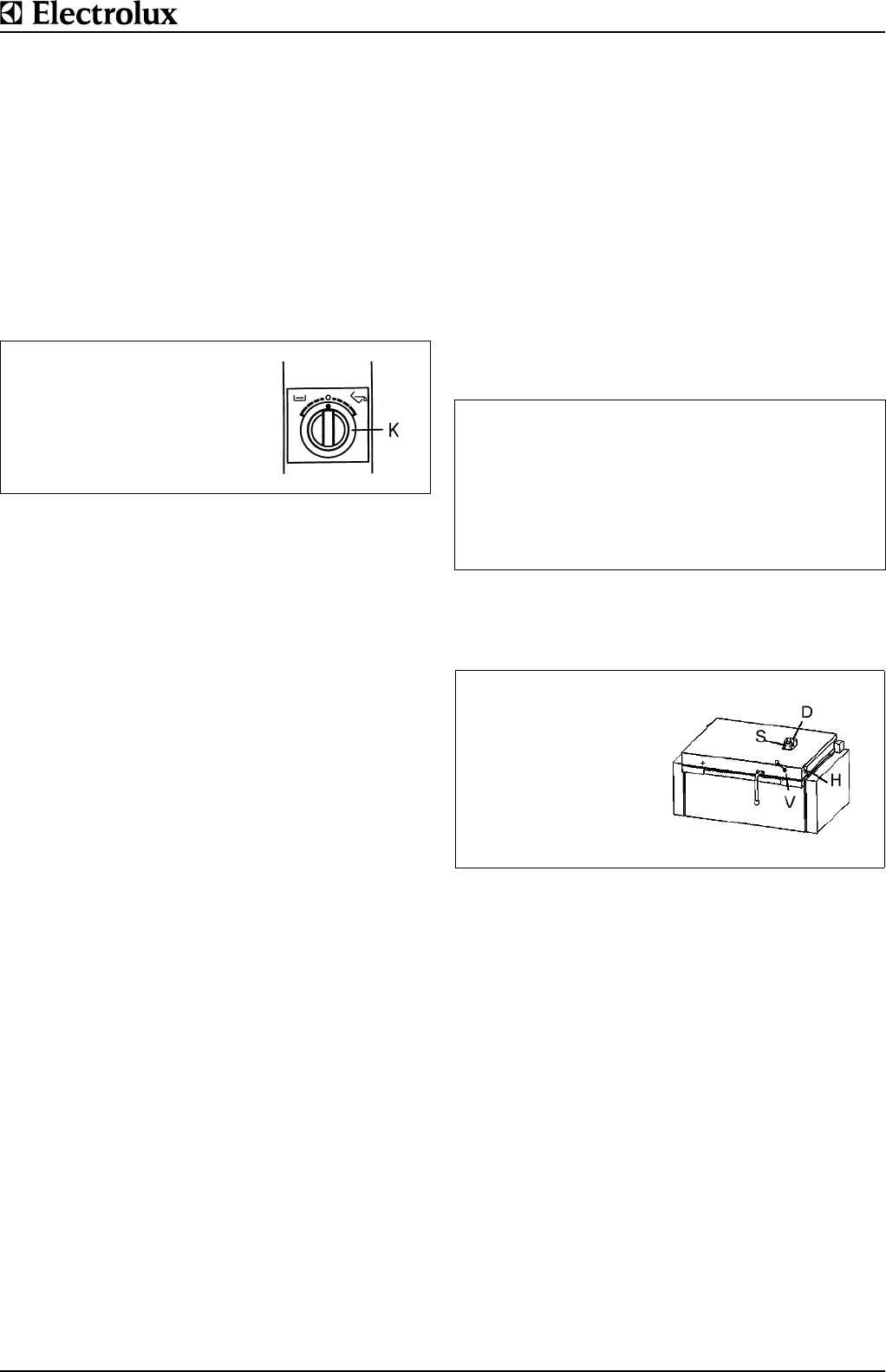
OPERATING INSTRUCTIONS
Page 8 62.9696.01
4.7 Tilting
MECHANICAL TILTING
The pan is tilted with the help of an electric motor. It only works
when the control switch (S) are switched on by turning from
position 0 to I.
0 = Off
I = On
Lamp (LS) will light up.
Tilting at variable speed by turning the tilting knob (K):
Emptying the pan turn to the right
Tilting back turn to the left
Turning the knob further will accelerate the tilting function.
.
Tilting is only to be activated with lid fully open and with the
swivel outlet of the water mixing unit in the correct position
(precisely towards the front) and where no object is present
under the appliance in the tilting zone. The pan is tilted down
by turning tilting switch clockwise (to the right) and tilted up by
turning it anti clockwise (to the left). Tilting at variable speed
will only take place as long as the tilting switch (K) is held in
the tilting position. On being released, the switch returns to the
neutral, centre position and due to the drive self-locking, the
boiling pan immediately comes to rest, whatever the position
and filling level. The tilting motor is automatically switched off
in the extreme positions of the pan; the horizontal and fully
tilted positions, so any further actuation of the tilting switch (K)
has no effect.
The heating can no longer be operated with even the smallest
degree of tilt from the horizontal.
Select the rate of tilting so that the produce is discharged in the
region of the pouring lip. This is easy to do by varying the tilting
speed. Avoid spillage of the contents over the rim of the boiling
pan.
4.8 Temperature settings
Temperature setting
Dependent on the cooking functions required, the temperature
selection button (T) on the display (AT) is used to set the fol-
lowing recommended temperatures:
Cooking 68° - 212°F (20° - 100°C)
Pressure-cooking 230° - 394°F (110° - 250°C)
Braising 356° - 394°F (180° - 250°C)
When pressure-cooking, select lower heating-up temperatures
(110°C) for low food quantities and higher temperatures
(250°C) for larger food quantities. If the desired value set
exceeds 230°F (110°C), this display will automatically revert to
the temperature < 230°F (110°C) when the working pressure is
reached. Any change to the desired value can then only be
made to set lower temperatures. Any new temperature value
setting can only be entered again after the appliance has been
switched off.
Cooking with pressure
After filling with water and food (either directly into the water or
in insert containers) adjust the temperature to 230°F (110°C)
and switch on the pan. The appliance starts to heat. After-
wards close the lid. The generated steam will press the
remaining air out of the pan. Therefore, the lid regulation and
safety valve must remain open (handle in position A) until only
steam evaporates out of the valve opening. Now, the valve is
to be closed (i.e. handle is to be moved to position B). Within
the pan, the pressure will be increased to 0,45 bar (corre-
sponding to 228°F (109 °C)) and remains constant. When the
heating is switched off, by hand or automatically, the pan
should be cooled during about 4-6 minutes, in order to decom-
pose the steam and the pressure
4.9 Switching off
The appliance is shut down by turning the power isolator (H)
(available as an option) as well as the control switch (S) to
zero. All lights will extinguish when this is done.
In the case of faults, the appliance must also be disconnected
from the electric supply connection.
4.10 Power failure
The loss of mains electricity while a cooking pan is being used
can result in cooking being halted or interrupted. Cooking staff
are then required to make an additional intervention in the con-
trols or to monitor further processing.
5. LID LOCK
5.1 Lid elements
H Lock lever
Causes the lock hook to snap in.
S Lid regulation and safety valve
Combined valve for manual operation and as safety valve
(blows off automatically at pressures above 6.5 psi (0.45 bar)).
Position:
D Steam outlet
The condensed steam flows out through this canalization.
V Steam release valve with safety lock
This valve predominantly has a safety function. With the valve
open, steam pressure for cooking cannot build up in the cook-
ing vessel. The steam release valve can be closed only when
the lid is properly closed and the lock mechanism is correctly
snapped in. Only then it is possible to build up the steam pres-
sure in the appliance.
Caution:
At the steam outlet (D/Fig. 5) large amounts of steam blow
out.
K Tilting knob
Fig. 4 Left-hand console (at the top)
Power failure when: The measure to be
implemented to restart the
cooking process after the
mains supply has been
restored
The cooking process is taking place Press the key (TT)
The cooking process has been programmed
with a starting time although this has not yet
expired
After the mains supply has been restored, the
starting time comes to an end and the heating
process starts automatically without any inter-
vention in the controls
D Steam outlet
H Lock lever
S Lid regulation and
safety valve
V Steam release valve
Fig. 5 Pressure lid - Locking


















